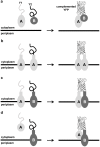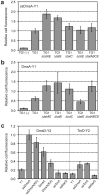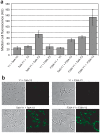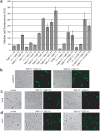Visualizing interactions along the Escherichia coli twin-arginine translocation pathway using protein fragment complementation
- PMID: 20169075
- PMCID: PMC2821923
- DOI: 10.1371/journal.pone.0009225
Visualizing interactions along the Escherichia coli twin-arginine translocation pathway using protein fragment complementation
Abstract
The twin-arginine translocation (Tat) pathway is well known for its ability to export fully folded substrate proteins out of the cytoplasm of gram-negative and gram-positive bacteria. Studies of this mechanism in Escherichia coli have identified numerous transient protein-protein interactions that guide export-competent proteins through the Tat pathway. To visualize these interactions, we have adapted bimolecular fluorescence complementation (BiFC) to detect protein-protein interactions along the Tat pathway of living cells. Fragments of the yellow fluorescent protein (YFP) were fused to soluble and transmembrane factors that participate in the translocation process including Tat substrates, Tat-specific proofreading chaperones and the integral membrane proteins TatABC that form the translocase. Fluorescence analysis of these YFP chimeras revealed a wide range of interactions such as the one between the Tat substrate dimethyl sulfoxide reductase (DmsA) and its dedicated proofreading chaperone DmsD. In addition, BiFC analysis illuminated homo- and hetero-oligomeric complexes of the TatA, TatB and TatC integral membrane proteins that were consistent with the current model of translocase assembly. In the case of TatBC assemblies, we provide the first evidence that these complexes are co-localized at the cell poles. Finally, we used this BiFC approach to capture interactions between the putative Tat receptor complex formed by TatBC and the DmsA substrate or its dedicated chaperone DmsD. Our results demonstrate that BiFC is a powerful approach for studying cytoplasmic and inner membrane interactions underlying bacterial secretory pathways.
Conflict of interest statement
Figures






Similar articles
-
DmsD, a Tat system specific chaperone, interacts with other general chaperones and proteins involved in the molybdenum cofactor biosynthesis.Biochim Biophys Acta. 2010 Jun;1804(6):1301-9. doi: 10.1016/j.bbapap.2010.01.022. Epub 2010 Feb 11. Biochim Biophys Acta. 2010. PMID: 20153451 Free PMC article.
-
The twin-arginine leader-binding protein, DmsD, interacts with the TatB and TatC subunits of the Escherichia coli twin-arginine translocase.J Biol Chem. 2003 Aug 29;278(35):32501-6. doi: 10.1074/jbc.M301076200. Epub 2003 Jun 17. J Biol Chem. 2003. PMID: 12813051
-
DmsD is required for the biogenesis of DMSO reductase in Escherichia coli but not for the interaction of the DmsA signal peptide with the Tat apparatus.FEBS Lett. 2003 Jan 16;534(1-3):156-60. doi: 10.1016/s0014-5793(02)03839-5. FEBS Lett. 2003. PMID: 12527378
-
Twin-arginine-dependent translocation of folded proteins.Philos Trans R Soc Lond B Biol Sci. 2012 Apr 19;367(1592):1029-46. doi: 10.1098/rstb.2011.0202. Philos Trans R Soc Lond B Biol Sci. 2012. PMID: 22411976 Free PMC article. Review.
-
Assembly of membrane-bound respiratory complexes by the Tat protein-transport system.Arch Microbiol. 2002 Aug;178(2):77-84. doi: 10.1007/s00203-002-0434-2. Epub 2002 May 22. Arch Microbiol. 2002. PMID: 12115052 Review.
Cited by
-
Mapping precursor-binding site on TatC subunit of twin arginine-specific protein translocase by site-specific photo cross-linking.J Biol Chem. 2012 Apr 13;287(16):13430-41. doi: 10.1074/jbc.M112.343798. Epub 2012 Feb 23. J Biol Chem. 2012. PMID: 22362773 Free PMC article.
-
Genetic evidence for a tight cooperation of TatB and TatC during productive recognition of twin-arginine (Tat) signal peptides in Escherichia coli.PLoS One. 2012;7(6):e39867. doi: 10.1371/journal.pone.0039867. Epub 2012 Jun 26. PLoS One. 2012. PMID: 22761916 Free PMC article.
-
DmsD, a Tat system specific chaperone, interacts with other general chaperones and proteins involved in the molybdenum cofactor biosynthesis.Biochim Biophys Acta. 2010 Jun;1804(6):1301-9. doi: 10.1016/j.bbapap.2010.01.022. Epub 2010 Feb 11. Biochim Biophys Acta. 2010. PMID: 20153451 Free PMC article.
-
Comparing system-specific chaperone interactions with their Tat dependent redox enzyme substrates.FEBS Lett. 2010 Nov 19;584(22):4553-8. doi: 10.1016/j.febslet.2010.10.043. Epub 2010 Oct 26. FEBS Lett. 2010. PMID: 20974141 Free PMC article.
-
Early contacts between substrate proteins and TatA translocase component in twin-arginine translocation.J Biol Chem. 2011 Dec 23;286(51):43679-43689. doi: 10.1074/jbc.M111.292565. Epub 2011 Oct 31. J Biol Chem. 2011. PMID: 22041896 Free PMC article.
References
-
- Mori H, Ito K. The Sec protein-translocation pathway. Trends Microbiol. 2001;9:494–500. - PubMed
-
- Driessen AJ, Fekkes P, van der Wolk JP. The Sec system. Curr Opin Microbiol. 1998;1:216–22. - PubMed
-
- Driessen AJ, Manting EH, van der Does C. The structural basis of protein targeting and translocation in bacteria. Nat Struct Biol. 2001;8:492–8. - PubMed
-
- Schatz G, Dobberstein B. Common principles of protein translocation across membranes. Science. 1996;271:1519–26. - PubMed
Publication types
MeSH terms
Substances
Grants and funding
LinkOut - more resources
Full Text Sources
Molecular Biology Databases

